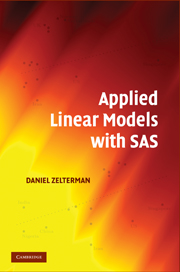Book contents
- Frontmatter
- Contents
- Preface
- Acknowledgments
- 1 Introduction
- 2 Principles of Statistics
- 3 Introduction to Linear Regression
- 4 Assessing the Regression
- 5 Multiple Linear Regression
- 6 Indicators, Interactions, and Transformations
- 7 Nonparametric Statistics
- 8 Logistic Regression
- 9 Diagnostics for Logistic Regression
- 10 Poisson Regression
- 11 Survival Analysis
- 12 Proportional Hazards Regression
- 13 Review of Methods
- Appendix: Statistical Tables
- References
- Selected Solutions and Hints
- Index
10 - Poisson Regression
Published online by Cambridge University Press: 05 June 2012
- Frontmatter
- Contents
- Preface
- Acknowledgments
- 1 Introduction
- 2 Principles of Statistics
- 3 Introduction to Linear Regression
- 4 Assessing the Regression
- 5 Multiple Linear Regression
- 6 Indicators, Interactions, and Transformations
- 7 Nonparametric Statistics
- 8 Logistic Regression
- 9 Diagnostics for Logistic Regression
- 10 Poisson Regression
- 11 Survival Analysis
- 12 Proportional Hazards Regression
- 13 Review of Methods
- Appendix: Statistical Tables
- References
- Selected Solutions and Hints
- Index
Summary
The Poisson distribution is the approximation to the binomial model when the n parameter is large and the p parameter is small. This is the most important discrete distribution for public health. Many individuals are at risk for an event that is very unlikely to occur to any one of them. Shark attacks, lottery winners, and lightning strikes are all good examples. So is the incidence of cancer, industrial injuries, surgical complications, and the births of twins.
Statistics in the News: Lottery Winners
Let us consider the example of people winning the lottery in several different towns in the New Haven area. The data is given in Table 10.1. There are a large number of people playing, many tickets are sold, but the probability of winning remains very small. Yet, as the advertisements point out, some people do win. In a town with a population of a few thousand, how can we develop mathematical models to describe the numbers of winners? What about characteristics of different towns: Do rural or urban settings have more winners? Do towns with higher property taxes have a different number of winners? How do we take different population sizes of the various towns into account? We show how to answer some of these questions and leave the remainder for the reader to complete in the exercise of Section 10.6.4.
- Type
- Chapter
- Information
- Applied Linear Models with SAS , pp. 204 - 224Publisher: Cambridge University PressPrint publication year: 2010



